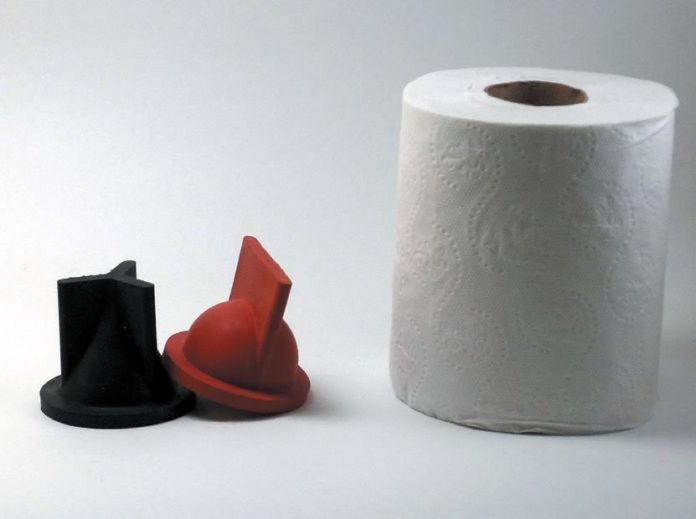Any suggestions about what to do with a clogged holding tank? I’ve isolated the clog to between the base of the tank and the elbow after the toilet macerator. I’ve been treating the system with straight vinegar down the pumpout tube and thru the bowl to no avail.
Anonymous Sailor
via PS Online
From the sounds of it, the vinegar is not reaching the clog site. Chemical drain cleaners can reduce build-up and can help on a slow drain, but once the blockage is complete, they can’t reach the problem. Much of our advice for cleaning a holding tank apply to your situation (see PS Advisor: Cleaning the Holding Tank, PS November 2015).
Remember, vinegar is a weak acid, barely able to dissolve lime scale and will have no effect on paper solids. Drain cleaners are used for paper, fats, and organics. These are strong bases (the opposite of acid), but we do not recommend these for marine systems because of the harm they can cause.
You could try stronger chemicals, but since they won’t reach the clog site anyway, they would only increase the risk of equipment damage or personal injury. A physical cleaning described in the 2015 PS Advisor report is going to be your best approach.
The first thing to try is reverse pressure. This will only work if the macerator pump does not include a check valve; diaphragm pumps contain check valves, centrifugal pumps generally do not (see Pump Details, the Modern Macerator, PS November 2011).
First, put your own high-pressure nozzle on the end of the washout hose. (This is to avoid contamination of the hose end, which is often used for water fill.) Fit the hose into the pumpout fitting and seal the gap with a wet rag and your hand. Let the water blast for 10-30 seconds, and then gradually release the seal. Don’t do this suddenly or you could get a mess in your face.
If this has no effect, try an adapter that will get a tighter seal. The pumpout is usually threaded 1 1/2-inch FPT threads. With an assortment of fittings you should be able to attach a male fitting to match and apply greater pressure. Be careful as you increase pressure. Although your discharge hose and fittings should be rated to at least 100 psi and dockside hose pressure is usually regulated to just 40 to 50 psi, your system might have some weak and aged components that might fail.
If a high pressure blast doesn’t work, try suction. Remove the fill fitting at the tank and construct a wand that fits down the hole, and suck the tank clean.
Once the holding tank is empty, take the plumbing apart and clean it according to the methods described in the 2015 PS Advisor. Sometimes the clog is a mass of paper that has collected against the outlet. If your tank has an access port, you can blast that area with a hose and pump out the buildup.
In the future, the best practice is to blast the hose down the pump-out fitting for at least 30 seconds after every pumpout, and then pump that out too. Shoot some water in the vent while you are at it. If you must use the dock-supplied nozzle fitting for this, avoid contact with your pumpout outlet and sanitize it with a chlorine wipe down. The last thing you want is for someone to fill their water tank with a contaminated hose end.
Never flush anything other than waste and dissolving single-ply toilet paper (no 2-ply, no facial tissues), and use plentiful water with every flush. These are vital preventative steps.
If further disassembly is required, keep your sense of humor. Like changing diapers, its just poop.


































Most holding tanks won’t take very much pressure. Be very careful how much pressure you apply.
Spraying water in the vent seems like a bad idea. Many (most?) vents have a charcoal filter attached. Getting water in them will clump of the odor absorbing media. This will both render the odor absorbing media ineffective, and block the vent line.
Ever try a flexible drain snake from the head first. If it goes thru to the tank repeat from the pump out fitting.
Hang a placard visible to anyone sitting on throne stating “If you haven,t eaten it first it dosn’t go down the hole”. Also develope a policy that the person who caused the clog clean up the mess after you fixed the cause.
Two words: composting head. Best decision we made when refitting our boat.
I made a ‘wand’ out of 1/2″ PEX tubing and a 3/8″ hose adapter. It is more than long enough to reach the tank and can be used to penetrate a blockage to help break it up. (Heat tube up in hot water then push in adapter.) Saw a video on making it at tanktechsrx.com
I spend my winters in Mexico. It is a national policy to never put paper down a toilet! Most toilets are on simple septic systems and paper just clogs them up. Same with a marine head! Composting head is even better…..
Do not empty the black or gray water tank directly into your home’s toilet! Otherwise, clogs may be an issue as toilets cannot be used to hold a large volume of waste coming from a boat or RV holding tank.
Yet, if you don’t want to empty your tank at a dump station. Do not worry, because you can learn how to do it yourself.
Take note that emptying your tank at home requires a cleanout. It will help dispose of the waste safely, whether you’re on a city sewer or septic system.